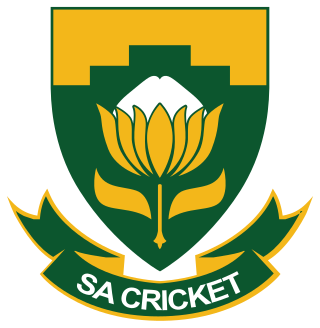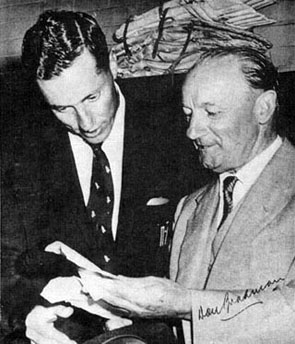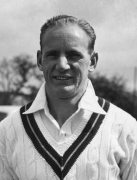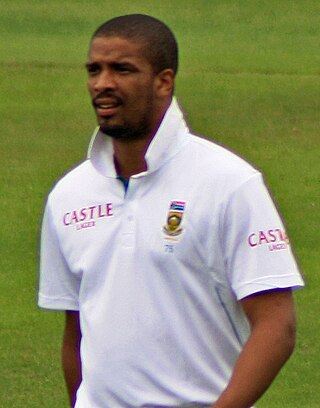| |||||
| Decades: | |||||
|---|---|---|---|---|---|
| See also: | |||||
The following lists events that happened during 1947 in South Africa.
| |||||
| Decades: | |||||
|---|---|---|---|---|---|
| See also: | |||||
The following lists events that happened during 1947 in South Africa.


Two new Cape gauge locomotive types enter service on the South African Railways (SAR):
The South Africa national cricket team tours England and plays five Test matches against the England national cricket team.
The South Africa national football team tours Australia and New Zealand and plays five games against the Australia national association football team and four against the New Zealand men's national football team.Team-H.Smethurst (capt.),L.G.Anley,A.G.Falconer,D.A.Wilson,H.D.McCreadie,R.H.F.Nicholson,D.D.Forbes,E.G.Dowell,S.van Rensburg, C.Kurland,R.Ferriman,H.E.Naish,J.H.Classens,H.J.Pretorius,J.H.M.Pickerill,C.L.Brink,B.Clack,S.O'Linn.J.H.Barbour (mgr).M.Taylor (ast.mgr).

Wessel Johannes Cronje was a South African international cricketer and captain of the South Africa national cricket team in the 1990s. A right-handed all-rounder, as captain Cronje led his team to victory in 27 Test matches and 99 One Day Internationals. Cronje also led South Africa to win the 1998 ICC KnockOut Trophy, the only major ICC title the country has won till date. In the 1998 ICC KnockOut Trophy Final, Cronje played a major role with the bat with his 61 not out, leading the team to victory by 4 wickets. He was voted the 11th-greatest South African in 2004 despite having been banned from cricket for life due to his role in a match-fixing scandal. He died in a plane crash in 2002.
The 1975 Cricket World Cup was the inaugural men's Cricket World Cup, and the first major tournament in the history of One Day International (ODI) cricket. Organised by the International Cricket Conference (ICC), it took place in England between 7 June and 21 June 1975.

The New Zealand national cricket team represents New Zealand in men's international cricket. Nicknamed the Black Caps, they played their first Test in 1930 against England in Christchurch, becoming the fifth country to play Test cricket. From 1930 New Zealand had to wait until 1956, more than 26 years, for its first Test victory, against the West Indies at Eden Park in Auckland. They played their first ODI in the 1972–73 season against Pakistan in Christchurch. New Zealand are the inaugural champions of WTC which they won in 2021 and they have also won ICC CT in 2000. They have played in the CWC final twice and the T20 WC final once.

The South Africa men's national cricket team, also known as the Proteas, represents South Africa in men's international cricket and is administered by Cricket South Africa (CSA). South Africa is a full member of the International Cricket Council (ICC). Its nickname derives from South Africa's national flower, Protea cynaroides, commonly known as the "King Protea".
This article describes the history of South African cricket from the aftermath of the First World War in 1919 to the end of the Second World War in 1945.

Herbert Wilfred Taylor was a South African cricketer who played 42 Test matches for his country including 18 as captain of the side. Specifically a batsman, he was an expert on the matting pitches which were prevalent in South Africa at the time and scored six of his seven centuries at home. His batting was also noted for quick footwork and exceptional 'backplay'. He became the first South African to pass 2,500 Test runs and was selected one of Wisden's Cricketers of the Year in 1925. In domestic cricket, he played for Natal, Transvaal and Western Province.

Hashim Mahomed Amla OIS is a South African former international cricketer who captained the national side in Tests and ODIs. Amla holds the record for being the fastest ever to score 3,000, 4,000, 6,000 and 7,000 ODI runs, and second fastest to reach 5,000 runs. He also became the fastest cricketer to reach 10 ODI centuries. He is widely regarded as one of the greatest batsmen to have played for South Africa, and one of the greatest opening batsmen of all time.
The following lists events that happened during 1909 in South Africa.

Trevor Leslie Goddard was a South African cricketer. A left-handed all-rounder, he played 41 Test matches for South Africa from 1955 to 1970. He captained the young South African team on its five-month tour of Australia and New Zealand in the 1963–64 season, levelling the series with Australia, and was also captain in 1964–65 against England in South Africa.

Edward Russell Henry Fuller was a South African cricketer who played in seven Test matches between 1953 and 1957. He was born in Worcester, Western Cape and died in Milnerton, Cape Town.
This article describes the history of South African cricket from its known beginnings until the end of the First World War in 1918.

Vernon Darryl Philander is a South African cricket coach, commentator, and former cricketer. He was a right-handed bowling all-rounder; he had previously represented his country at under 19 level. He played for the South Africa national cricket team and Cape Cobras in South African domestic cricket. In December 2019, ahead of a Test series against England, Philander announced that the series would be his last series before retiring from international cricket.
The New Zealand national cricket team toured South Africa from October 1961 to February 1962 and played a five-match Test series against the South Africa national cricket team. The series was drawn 2–2, with New Zealand's victory in the third Test the team's first Test match win outside their home country. New Zealand captain John Reid scored a total of 1,915 runs during the tour, setting a record for the most runs scored in South Africa by a touring batsman. The tour was the second to South Africa by a team from New Zealand, the previous tour having taken place in 1953–54.

Cricket is the most popular summer sport in Australia at international, domestic and local levels. It is important culturally and regarded as a national sport, and is widely played across the country, especially from the months of September to April. It was one of the first of Australia's mainstream sports to be established, having begun in the Colony of New South Wales as early as December 1803. The peak administrative body for both professional and amateur cricket is Cricket Australia.
This article describes the history of South African cricket from the end of the Second World War in 1945 to the start of South Africa's cricket isolation in 1970.
South Africa resumed official international cricket in 1991 after the moratorium imposed by the International Cricket Conference in 1970 was lifted. This was the first edition of the sir Vivian Richards trophy. This had restricted official contact with South Africa as a response to the policy of apartheid and South Africa's refusal to select non-white players for their international sporting teams. It formed part of the wider sporting boycott of South Africa during the apartheid era. The South African national team made a short tour of India in 1991. It then played in the 1992 Cricket World Cup in Australia and New Zealand. The decade saw a number of tours of South Africa by major international teams as well as the continued playing of domestic competitions.
This article describes the history of South African cricket from the 2000–01 season. Noted South African players in the 21st century have included Jacques Kallis, Shaun Pollock, Makhaya Ntini, Mark Boucher, Graeme Smith and Herschelle Gibbs.
The England cricket team toured South Africa under the auspices of the Marylebone Cricket Club from December 1905 to March 1906. There were five Test matches, and seven first-class games against South African provincial teams. While the team won a number of their first-class matches, they also lost several, and South Africa won the Test series 4 to 1.

Thomas Kevin Curran, is an English cricketer who represents England in Test matches, One Day Internationals and Twenty20 Internationals. He plays for Surrey County Cricket Club in English domestic cricket. He is a right-arm fast-medium bowling all-rounder. He made his international debut for England in June 2017. He is the son of former Zimbabwe international cricketer Kevin Curran, and the brother of both Zimbabwe batsman Ben Curran and England and Surrey all-rounder Sam Curran.

Keshav Athmanand Maharaj is a South African professional cricketer. Maharaj represents the South Africa national team in Tests, One Day International (ODI) and Twenty20 International (T20I) cricket. He is currently the vice-captain of the side in limited overs cricket. Maharaj also captains Durban's Super Giants in the SA20.